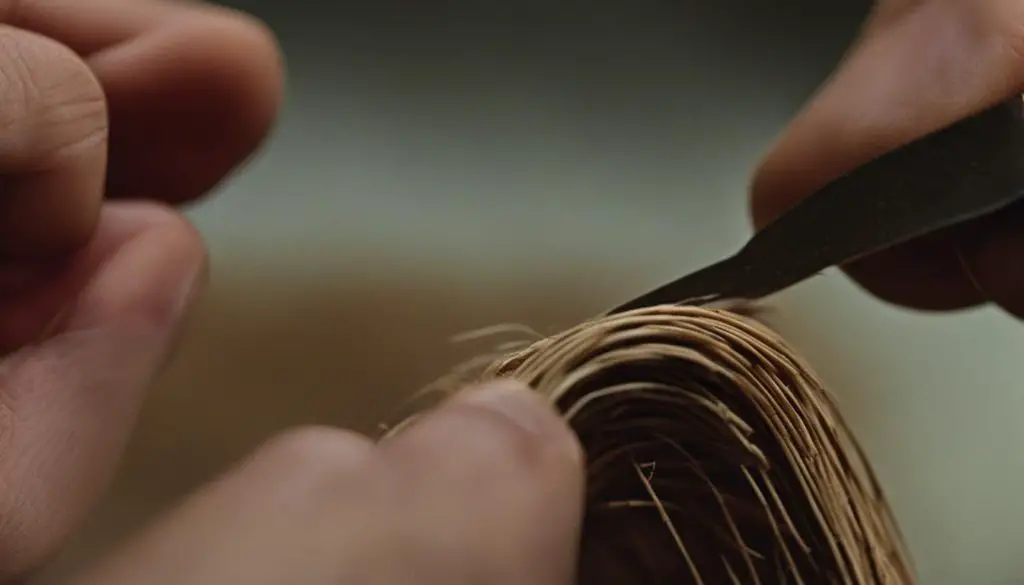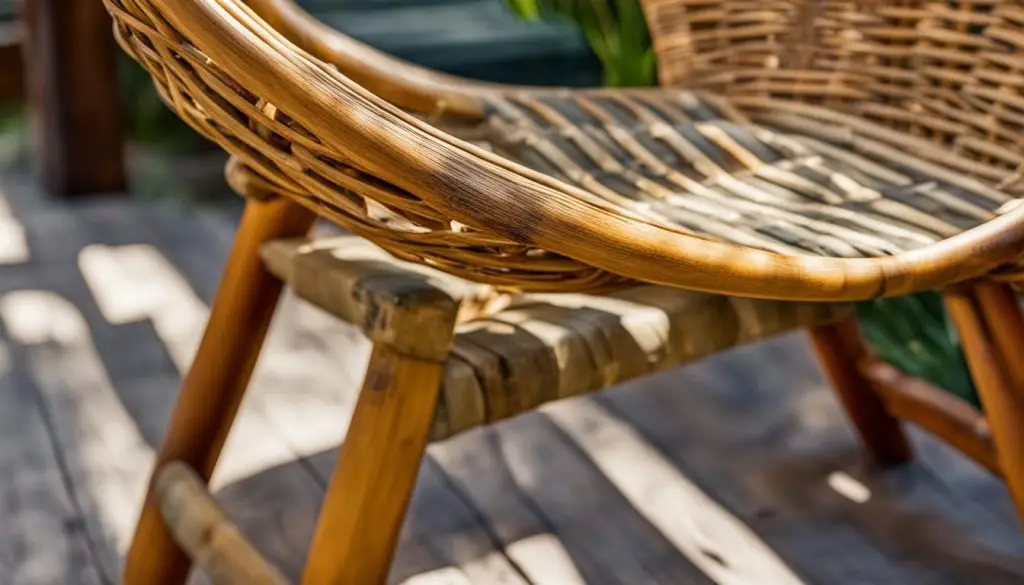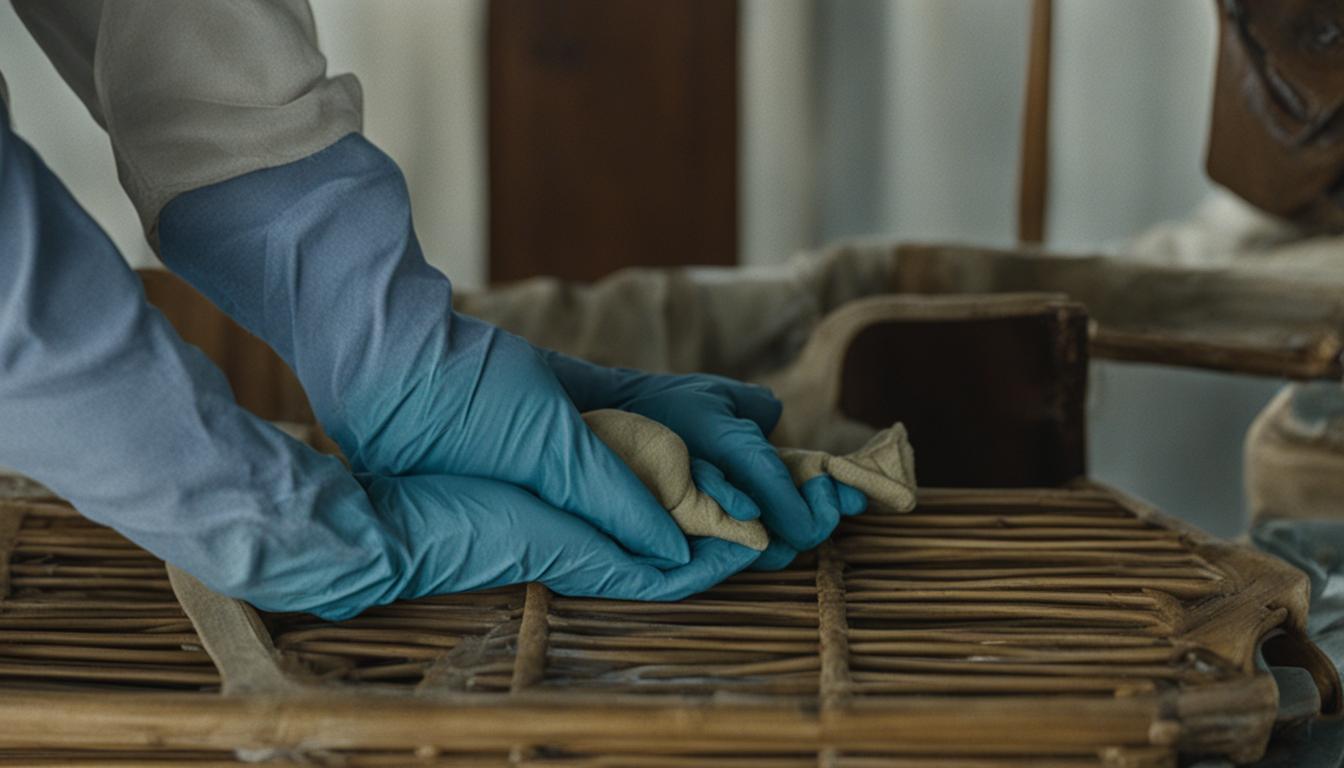Restoring rattan furniture can be a simple and rewarding project to revive the beauty of your wicker pieces. With the right techniques and tools, you can bring back the original color and shine of your rattan furniture. In this guide, I will provide you with step-by-step instructions on how to restore rattan furniture at home.
Key Takeaways:
- Restoring rattan furniture at home is a feasible DIY project.
- Clean and prepare the furniture properly before starting the restoration process.
- Repair broken rattan strands using replacement materials and glue.
- Consider refinishing the furniture with paint for a fresh look.
- Seal and protect the restored surfaces to ensure longevity.
Cleaning and Preparing the Furniture
Before diving into the restoration process, it is crucial to thoroughly clean and prepare your rattan furniture. This step ensures that the restoration efforts are effective and long-lasting. Cleaning the furniture helps remove dirt, grime, and grease that may have accumulated over time, while preparing it ensures a smooth surface for the restoration process.
Cleaning the Rattan Furniture
To clean your rattan furniture, start by using a cleaning solution specifically designed for rattan or wicker. Alternatively, you can create your own solution by mixing dish soap with warm water. Using a soft cloth or sponge, gently wipe down the entire surface of the furniture, paying special attention to any intricate designs or crevices. This will help remove any dirt or debris that may have settled into the rattan.
After cleaning, rinse the furniture with clean water to remove any residual cleaning solution. Be sure to dry the furniture thoroughly before proceeding to the next step. This will prevent any moisture from seeping into the rattan during the restoration process.
Preparing the Rattan Furniture
Once the furniture is clean and dry, it is important to prepare the rattan for the restoration process. Start by examining the furniture for any broken or damaged pieces of rattan. Trim off these broken strands using a pair of scissors or pliers. This will ensure that the restoration process starts with a solid foundation.
Next, gently sand the surface of the rattan using 120 grit sandpaper. This step helps create a smooth and even surface for the restoration materials, such as paint or varnish, to adhere to. Be careful not to sand too aggressively, as it may damage the rattan fibers.
By thoroughly cleaning and preparing your rattan furniture, you set the stage for a successful restoration process. This ensures that the end result is not only aesthetically pleasing but also durable and long-lasting.
Repairing Broken Rattan Furniture
When restoring rattan furniture, one common issue you may encounter is broken strands. Luckily, it is possible to repair these broken strands and restore the integrity and aesthetics of your furniture. Repairing broken rattan requires some basic tools and materials, but with a little patience and care, you can achieve great results.
To repair broken rattan strands, start by identifying the damaged sections. Use a pair of pliers or scissors to carefully cut away the broken strands, ensuring to remove any loose pieces that may be sticking out. Measure and cut a new replacement strand slightly longer than the damaged section to ensure a proper fit.
Before inserting the replacement strand, soak it in water for a few minutes. This will make the rattan more pliable and easier to weave into the furniture. Apply a small amount of super glue to one end of the replacement strand and press it firmly in place for about 5 minutes to allow it to bond securely. Once the glue has dried, carefully weave the rest of the new strand into the surrounding rattan, following the existing pattern. Trim off any excess material and use a dab of glue to secure the end.
By following these steps, you can effectively repair broken rattan strands in your furniture and restore its structural integrity. Taking the time to address and fix these issues will ensure that your rattan furniture remains in good condition for years to come.

Table: Required Tools for Repairing Broken Rattan
| Tool | Description |
|---|---|
| Pliers or Scissors | Used to cut away broken strands |
| Replacement Rattan | New strands to replace the broken ones |
| Super Glue | Used to secure the replacement strands in place |
| Water | Soaking the replacement strands to make them more pliable |
Refinishing Rattan Furniture with Paint
One popular way to give your rattan furniture a fresh and updated look is by refinishing it with paint. This method not only allows you to change the color of your furniture but also adds a layer of protection to the rattan. Refinishing your rattan furniture with paint is a DIY project that can be easily accomplished with the right tools and techniques.
To start the refinishing process, it’s important to clean your rattan furniture thoroughly to remove any dirt or grime. Use a mild detergent or a mixture of dish soap and water to wipe down the surface. Allow the furniture to dry completely before proceeding.
Next, tape off any areas of the furniture that you don’t want to paint, such as metal or glass parts. This will help you achieve clean and precise lines. Use a primer spray paint to create a smooth base for the paint to adhere to. Apply two coats of your chosen color of spray paint, allowing each coat to dry completely before applying the next. For a natural look, consider using a fossil color as the base and adding a lighter khaki color to bring back warmth to the piece.
Finish the restoration process by applying a matte topcoat to protect the paint and add a professional finish. The topcoat will help prevent the paint from chipping or peeling over time. Apply multiple thin coats, allowing each coat to dry before applying the next. Make sure to cover all areas of the furniture, including the intricate textures and grooves. Once the topcoat is completely dry, your rattan furniture will have a renewed and polished appearance.

Benefits of Refinishing Rattan Furniture with Paint
- Allows you to change the color of your rattan furniture
- Provides added protection to the rattan surface
- Gives your furniture a fresh and updated look
- Helps cover up any imperfections or discoloration
“Refinishing your rattan furniture with paint is a cost-effective way to transform the look of your wicker pieces and breathe new life into them.”
Whether you choose a bold and vibrant color or a more subtle and neutral tone, refinishing your rattan furniture with paint is a great way to personalize your pieces and add a touch of style to your home.
Sealing and Protecting the Restored Furniture
Once you have completed the restoration process and brought your rattan furniture back to its former glory, it is essential to seal and protect the newly transformed surfaces. This final step will not only enhance the appearance of your furniture but also prolong its lifespan. Applying a clear gloss polycrylic or a suitable topcoat will add a protective layer that shields the rattan from everyday wear and tear, as well as spills and stains. The topcoat will also provide a beautiful shine, accentuating the natural beauty of the rattan.
When sealing your restored rattan furniture, it is crucial to apply multiple coats of the topcoat. This is especially important for the areas with grooves, textures, and intricate patterns, as they require extra protection. Make sure to follow the manufacturer’s instructions regarding the drying time between each coat. By allowing sufficient drying time, you ensure that the topcoat fully adheres to the rattan surface, resulting in a more durable and long-lasting finish.
Remember to be thorough in your application, covering all exposed areas of the furniture. A well-sealed piece of rattan furniture will not only be resistant to spills and stains but also easier to clean and maintain. It will provide a protective barrier against moisture and UV rays, preventing fading, cracking, and warping. By sealing and protecting your restored rattan furniture, you can enjoy its beauty and functionality for many years to come.
Tips for Sealing and Protecting Rattan Furniture:
- Choose a clear gloss polycrylic or topcoat specifically formulated for use on wicker and rattan furniture.
- Apply multiple coats of the topcoat to ensure thorough protection.
- Pay special attention to areas with grooves and textures, as they require additional coats.
- Follow the manufacturer’s instructions for drying time between each coat.
- Use a soft brush or foam applicator to apply the topcoat evenly.
- Avoid applying too much pressure, as it may cause the rattan to fray or break.
- Allow the topcoat to dry completely before using or placing any objects on the furniture.
By following these tips and properly sealing and protecting your restored rattan furniture, you can maintain its beauty and durability for years to come. With regular maintenance and care, your rattan pieces will continue to bring charm and sophistication to your space.
Maintenance Tips for Longevity
To keep your restored rattan furniture looking its best, proper maintenance is essential. Follow these tips to ensure the longevity and beauty of your rattan pieces.
1. Avoid direct sunlight and extreme temperatures
Rattan furniture is best kept away from direct sunlight and extreme temperature changes. Prolonged exposure to the sun’s rays can cause the rattan to fade and become brittle. Similarly, extreme temperature fluctuations can lead to cracking and warping. Position your furniture in a shaded area to protect it from these damaging effects.
2. Regular cleaning
Regular cleaning is crucial to remove dust, dirt, and stains from your rattan furniture. Use a mild detergent or soapy water solution and a soft cloth to wipe down the surfaces. Avoid using harsh chemicals or abrasive cleaners that can damage the finish. Gently scrub any stubborn stains with a soft-bristled brush. After cleaning, make sure to dry the furniture thoroughly to prevent moisture from seeping in.
3. Check for loose strands and repairs
Periodically inspect your rattan furniture for any loose strands or areas that may need repair. Over time, the weaving may loosen or strands may break. If you notice any issues, it’s essential to address them promptly to prevent further damage. You can repair loose strands by applying a small amount of wood glue or using a needle and thread to secure them back in place. For more extensive repairs, consider seeking assistance from a professional.
4. Avoid placing heavy objects
Rattan furniture, although durable, is not designed to support heavy objects or excessive weight. Avoid placing heavy items on your rattan pieces, as this can lead to sagging, bending, or even breakage. Use caution when moving or rearranging your furniture to prevent accidental damage.
By following these maintenance tips, you can enjoy the beauty and functionality of your restored rattan furniture for years to come.
Where to Find Replacement Rattan Material
When restoring rattan furniture, you may encounter the need for replacement rattan strands or sections. Finding the right materials is crucial to ensure a seamless repair and preserve the authenticity of your furniture. Fortunately, there are several options available for sourcing replacement rattan material, both online and offline.
Local Furniture Repair Shops
One of the best places to find replacement rattan material is at local furniture repair shops. These establishments often specialize in repairing and restoring various types of furniture, including rattan pieces. They may carry a variety of rattan materials in different sizes and colors, making it easier for you to find a match for your furniture. Visit your nearest furniture repair shop and inquire about their rattan supplies.
Online Retailers
If you prefer the convenience of shopping from home, online retailers are an excellent option for finding replacement rattan material. Many online stores specialize in rattan supplies, offering a wide selection of materials to choose from. Simply search for “replacement rattan material” or “where to buy rattan material” to find reputable online retailers. Take accurate measurements of the rattan strands or sections you need to replace and ensure that the materials you purchase closely match the existing rattan for a seamless blend.
| Retailer | Website | Specialty |
|---|---|---|
| Rattan Paradise | www.rattanparadise.com | Wide selection of rattan supplies |
| Wicker Paradise | www.wickerparadise.com | Rattan and wicker materials |
| Rattan Direct | www.rattandirect.co.uk | Various types of rattan materials |
Local Craft and Hobby Stores
Don’t overlook your local craft and hobby stores when searching for replacement rattan material. These stores often carry a range of materials for DIY projects, including rattan supplies. While their selection may be more limited compared to specialty retailers, you may find the materials you need for smaller repairs or touch-ups. Pay a visit to craft and hobby stores in your area and explore their inventory.
By knowing where to find replacement rattan material, you can ensure that your furniture restoration project is a success. Whether you choose to visit local furniture repair shops, browse online retailers, or explore craft and hobby stores, the right materials are within reach. Remember to take accurate measurements and select materials that closely match the existing rattan for a seamless repair. With the proper materials and techniques, you can breathe new life into your rattan furniture and enjoy its beauty for years to come.
DIY vs. Professional Restoration
When it comes to restoring your rattan furniture, you have two options: DIY or professional restoration. Both approaches have their advantages and considerations, so it’s important to weigh your options and choose the one that best fits your needs and preferences.
DIY Rattan Furniture Restoration: Choosing to restore your rattan furniture on your own can be a rewarding experience. It allows you to save money and have a hands-on approach to the restoration process. With the right tools, materials, and guidance, you can achieve impressive results.
However, it’s important to note that DIY restoration requires time, patience, and a certain level of skill. You’ll need to invest time in researching and learning the proper techniques for cleaning, repairing, refinishing, and maintaining your rattan furniture. Additionally, you’ll need to gather the necessary tools and materials to ensure a successful restoration.
Professional Rattan Furniture Restoration: If you prefer a high-quality result without the hassle of DIY, professional restoration is a great option. Hiring professionals who specialize in restoring rattan furniture ensures that your pieces will be expertly repaired, refinished, and maintained.
Professional restoration may come at a higher cost compared to DIY, but it offers several benefits. Professionals have the expertise and experience to handle even the most challenging restoration projects. They also have access to specialized tools, materials, and techniques that may not be readily available to DIY enthusiasts.
| DIY Restoration | Professional Restoration | |
|---|---|---|
| Pros | – Cost-effective – Hands-on experience – Personal satisfaction | – High-quality results – Expertise and experience – Access to specialized tools and materials |
| Cons | – Time-consuming – Requires skill and research – Limited access to tools and materials | – Higher cost – Lack of personal involvement – Dependence on professionals |
Table: DIY vs. Professional Restoration
Ultimately, the choice between DIY and professional restoration depends on your skills, time availability, and budget. If you enjoy hands-on projects and have the necessary resources, DIY restoration can be a fulfilling and cost-effective option. On the other hand, if you prioritize a high-quality result and prefer to leave the restoration process to experts, professional restoration is worth considering.
Conclusion
In conclusion, restoring rattan furniture is a rewarding and creative endeavor that allows you to revive the beauty of your wicker pieces. By following the step-by-step instructions provided in this guide, you can bring back the original color and shine of your rattan furniture and enjoy its durability for years to come.
It is important to start the restoration process by cleaning and preparing the furniture, ensuring that it is free from dirt, grease, and grime. Repairing any broken rattan strands is also crucial to maintain the structural integrity of the furniture.
Refinishing the rattan furniture with paint offers a great opportunity to give it a fresh and updated look. Choosing the right paint color and applying a protective topcoat will ensure a long-lasting finish. Finally, sealing and protecting the restored furniture is essential to maintain its newly restored surfaces.
Whether you decide to embark on a DIY restoration journey or seek professional assistance, restoring rattan furniture is a great way to enhance your home’s aesthetic and preserve the charm of these timeless pieces. With proper maintenance and care, your restored rattan furniture will continue to bring beauty and style to your living space.
FAQ
How do I clean rattan furniture before restoring it?
Use a cleaning solution like Krud Kutter or a mixture of dish soap and water to wipe down the surface of the rattan. Additionally, trim off any broken pieces of rattan and gently sand the surface with 120 grit sandpaper to prepare it for the restoration process.
How can I repair broken rattan strands in my furniture?
Use a pair of pliers or scissors to cut away the damaged rattan strands. Measure and cut a new replacement strand slightly longer than the damaged section. Soak the replacement rattan strands in water to make them more pliable. Apply super glue to one end of the replacement strand and press it in place for 5 minutes. Weave the rest of the new strand into the furniture, trimming off any excess material and securing the end with glue.
Can I refinish my rattan furniture with paint?
Yes, painting rattan furniture is a popular way to give it a fresh and updated look. Start by cleaning it thoroughly and taping off any areas you don’t want to paint. Use a primer spray paint to create a smooth base, followed by 2 coats of your chosen color of spray paint.
How do I seal and protect the restored rattan furniture?
Apply a clear gloss polycrylic or another suitable topcoat to add shine and protection to the paint. Make sure to apply multiple coats, especially to the areas with grooves and textures. Allow the topcoat to dry completely before using or placing any objects on the furniture.
What maintenance tips should I follow for my restored rattan furniture?
Avoid placing the furniture in direct sunlight or exposing it to extreme temperatures. Regularly clean the furniture with a mild detergent and a soft cloth, avoiding harsh chemicals that may damage the finish. Additionally, periodically check for any loose strands or areas that may need repair to ensure the longevity of your restored rattan furniture.
Where can I find replacement rattan material for my furniture?
Look for local furniture repair shops or online retailers that specialize in rattan supplies. They may offer a variety of rattan materials in different sizes and colors to match your furniture. Make sure to take accurate measurements and choose materials that closely match the existing rattan for a seamless repair.
Should I restore my rattan furniture myself or hire professionals?
Whether you choose to embark on a DIY restoration journey or seek professional assistance, consider your skills, time availability, and budget. DIY restoration allows you to save money and have a hands-on experience, but it requires time, patience, and the necessary tools and materials. On the other hand, professional restoration ensures a high-quality result but comes at a higher cost.


